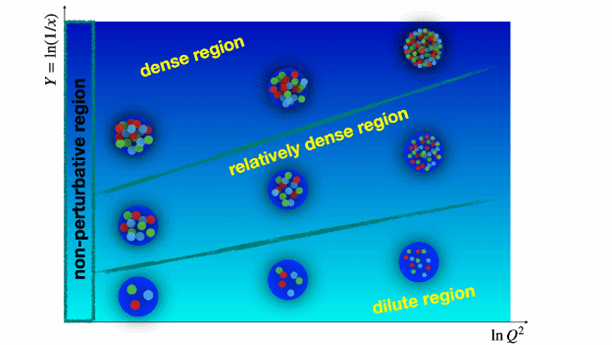Recently, Professor Wang Xinnian and his collaborative team from the Institute of Particle Physics at Central China Normal University (CCNU) made significant progress in the study of quantum chromodynamics (QCD) factorization theory. Their findings were simultaneously published in Physical Review Letters (Phys. Rev. Lett. 135, 032301 (2025)) [1] and Physical Review D (Phys. Rev. D 112, 014029 (2025)) [2].

Figure 1: Schematic diagram of the parton density phase diagram in nuclear matter
For a long time, two theoretical frameworks have been used to describe the distributions of quarks and gluons in nuclear media: the Color Glass Condensate (CGC) effective theory and the high-twist (HT) collinear factorization theory. CGC and HT have been regarded as independent frameworks for describing perturbative QCD multiple scattering in nuclear media, each valid in different kinematic regions. CGC is widely applied in the high-energy limit for the dense parton density regime at very small *x*, while HT provides a reliable description for the relatively moderate parton density regime at *x* ≤ O(1). Despite their individual successes, establishing consistency between these two theories in their overlapping transition region—where both are applicable—has remained a major challenge in the field.
A research team composed of scientists from South China Normal University (SCNU), Central China Normal University (CCNU), the University of California, Los Angeles (UCLA), and other institutions has, for the first time, clarified the relationship between CGC and HT at the level of physically observable quantities, using direct photon production in proton-nucleus collisions as an example. The key breakthrough lies in the team’s extension beyond the shock-wave approximation, fully accounting for the Landau-Pomeranchuk-Migdal (LPM) interference effect. The LPM effect describes the relationship between the formation time of radiated particles and the distance between scattering centers in the medium, playing a crucial role in the precise matching of CGC and HT in the finite *x* region. By incorporating these "sub-eikonal phases" and the relevant Feynman diagrams associated with LPM interference, the team demonstrated that the CGC effective theory—when extended beyond the shock-wave approximation and including LPM effects—exhibits full consistency with the HT framework in their overlapping transition region. This marks the first proof of CGC and HT consistency at the twist-4 level.
This research develops a unified factorization framework to describe the parton density phase diagram of nuclear matter, spanning from sparse to dense dynamics. It provides a theoretical foundation for mapping the parton density phase diagram using experimental data from major scientific facilities such as the Relativistic Heavy Ion Collider (RHIC) and the Large Hadron Collider (LHC), as well as future measurements from the Electron-Ion Collider (EIC). This work is expected to offer critical theoretical input for the search for gluon saturation signals. The framework can also be broadly extended to other processes, such as single-hadron production in proton-nucleus collisions and dijet production in deep inelastic scattering.
This achievement was accomplished through collaboration between the National Key Laboratory of Nuclear Physics and Nuclear Technology, Researcher Xing Hongxi from the Institute of Quantum Matter at South China Normal University, Professor Wang Xinnian’s research group at the Institute of Particle Physics at Central China Normal University, and Professor Kang Zhongbo’s research group at the University of California, Los Angeles. The research was supported by grants from the National Natural Science Foundation of China and the Guangdong Major Project of Basic and Applied Basic Research.
[1] https://journals.aps.org/prl/pdf/10.1103/PhysRevLett.135.032301
[2] https://journals.aps.org/prd/pdf/10.1103/ckhv-5213
CCNU School of Physics Party Committee Media Center
CCNU School of Physics Youth League Committee Propaganda Center
Correspondent | Xing Hongxi
Editor | Huang Jiancong
Reviewers | Qin Guangyou, Zhao Yunjie